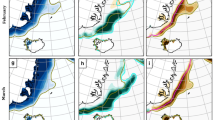Abstract
The response of the LLN 2-D climate model to the insolation and CO2 forcings during the Eemian interglacial is compared to reconstructions obtained from deep-sea cores drilled in the Norwegian Sea and in the North Atlantic. Both reconstructions and modeling results show a decrease of sea-surface temperature (SST) in the higher latitudes (70–75°N zonal belt for the model and the Norwegian Sea for the proxy records), associated with a more moderate cooling at lower latitudes (50–55°N and North Atlantic), at the middle of isotopic substage 5e, several millenia before the beginning of continental ice-sheet growth. Such a comparison between the simulated SST and ice volume of the Northern Hemisphere has been extended to the whole last glacial-interglacial cycle. The influence of the insolation forcing on SST and the shortcomings of the model due to its zonal character are discussed.
Similar content being viewed by others
References
Barnola JM, Raynaud D, Korotkevich YS,Lorius C (1987) Vostok ice core provides 160000-year record of atmospheric CO2. Nature 329 (6138):408–414
Berger A (1978) Long term variations of daily insolations and Quaternary climatic changes. J Atmos Sci 35 (12):2362–2367
Berger A (1979) Insolation signatures of Quaternary climatic changes. 11 Nuovo Cimento 2C (1):63–87
Berger A, Gallée H, Tricot C (1993a) Glaciation and deglaciation mechanisms in a coupled two-dimensional climate-ice-sheet model. J Glaciol 131 (39):45–49
Berger A, Tricot C, Gallée H, Loutre MF (1993b) Water vapour, CO2 and insolation over the last glacial-interglacial cycles. Philos Trans R Soc London B 341:253–261
Berger A, Loutre MF, Tricot C (1993c) Insolation and Earth's orbital periods. J Geophys Res 98 (D6):10341–10362
Cortijo E, Duplessy JC, Labeyrie L, Leclaire H, Duprat J, van Weering TCE (1994) Eemian cooling in the Norwegian sea and North Atlantic ocean preceding continental Ice-sheet growth. Nature 372:446–449
Fichefet T, Hovine S, Duplessy JC (1994) A model study of the Atlantic thermohaline circulation during the last glacial maximum. Nature 372:252–255
Gallée H, van Ypersele JP, Fichefet T, Tricot C, Berger A (1991) Simulation of the last glacial cycle by a coupled, sectorially averaged climate - ice-sheet model. I. The climate model. J Geophys Res 96 (D7):13139–13161
Gallée H, van Ypersele JP, Fichefet T, Marsiat I, Tricot C, Berger A (1992) Simulation of the last glacial cycle by a coupled, sectorially averaged climate-ice-sheet model. Part II. Response to insolation and CO2 variation. J Geophys Res 97 (D14):15713–15740
Gallée H, Berger A, Shackleton NJ (1993) Simulation of the climate of the last 200 ky with the LLN 2D-model. In: Peltier R (ed) Ice in the climate system. NATO ASI Series I, Global Environmental Change vol 12, Springer, Berlin Heidelberg New York, pp 321–341
Greenland Ice-Core Project (GRIP) Members (1993) Climate instability during the last interglacial period recorded in the GRIP ice core. Nature 364:203–207
Harvey LDD (1988) On the role of high latituole ice, snow and vegetation feedbacks in the climatic response to external forcing change. Clim. Change, 13, 181–224
Hovine S, Fichefet T (1994) A zonally averaged, three-basin ocean circulation model for climate studies. Clim Dyn 10:313–331
Houghton JT, Callander BA, Varney SK (eds) (1992) Climate change. The supplementary Report to the IPCC Scientific Assessment. WMO UNEP. Cambridge University Press, Cambridge, UK
Houghton JT, Meira Filho LG, Callander BA, Harris N, Kattenberg A, Maskell K (1996) Climate change 1995. The science of Climate change. Contribution of WGI to the Second Assessment Report of the Intergovernmental Panel on Climate Change. Cambridge University Press, Cambridge, UK
Imbrie J, Imbrie JZ (1980) Modelling the climatic response to the orbital variations. Science 207 (29):943–953
Imbrie J, Hays J, Martinson DG, McIntyre A, Mix AC, Morley JJ, Pisias NG, Prell WL, Shackleton NJ (1984) The orbital theory of Pleistocene climate: support from a revised Chronology of the marine δ18O record. In: Berger A, Imbrie J, Hays J, Kukla G, Saltzman B (eds) Milankovitch and climate. Reidel, Dordrecht, Holland, pp 269–305
Jouzel J, Barkov NI, Barnola JM, Bender M, Chappellaz J, Genthon C, Kotlyakov VM, Lipenkov V, Lorius CI, Petit JR, Raynaud D, Raisbeck G, Ritz C, Sowers T, Stievenard M, Yiou F, Yiou P (1993) Vostok ice cores: extending the climatic records over the penultimate glacial period. Nature 364 (6436):407–412
Koc Karpuz N, Schrader H (1990) Surface sediment diatom distribution and holocene paleotemperature variations in the Greenland, Iceland and Norwegian Sea. Paleoceanography 5 (4):557–580
Koc N, Jansen E (1994) Response of the high latitude Northern Hemisphere to orbital climate forcing. Geology 22:523–526
Labeyrie LD, Labracherie M, Gorfti N, Pichon JJ, Duprat J, Vautravers J, Arnold M, Duplessy JC, Paterne M, Michel E, Caralp J, Tuon JL (1995) Hydrological changes of the Southern Ocean (South-east Indian sector) over the last 230 ky. Paleoceanography (in press)
Martinson DG, Pisisas NG, Hays JD, Imbrie J, Moore TC, Shackleton NJ (1987) Age dating and the orbital theory of the ice ages: development of a high-resolution 0 to 300000-year chronostratigraphy. Quat Res 27 (1):1–29
Milankovitch M (1941) Kanon der Erdbestrahlung und seine Anwendung auf das Eiszeitenproblem. Royal Serbian Sciences, Spec Publ 132, Mathematical and Natural Sciences, vol 33, Belgrade. (‘Canon of insolation and the ice age problem’, English translation: Israel Program for Scientific Translation, published by US Department of Commerce and the National Science Foundation, Washington D.C.) 1969
Milankovitch M (1995) Milutin Milankovic. European Geophysical Society, Katlenburg-Lindau, Germany
Prell WL (1985) The stability of low-latitude sea-surface temperatures: an evaluation of the CLIMAP reconstruction with emphasis on the positive SST anomalies. Rep TR 025, US Department of Energy, Washington, DC
Ruddiman WF, McIntyre A (1979) Warmth of the subpolar North Atlantic ocean during Northern Hemisphere ice-sheet growth. Science 204 (4389):173–175
Shackleton NJ, Le J, Mix A, Hall MA (1992) Carbon isotope records from Pacific surface waters and atmospheric carbon dioxide. Quat Sci Rev 11:387–400
Author information
Authors and Affiliations
Rights and permissions
About this article
Cite this article
Berger, A., Gallée, H., Li, X.S. et al. Ice-sheet growth and high-latitudes sea-surface temperature. Climate Dynamics 12, 441–448 (1996). https://doi.org/10.1007/BF02346817
Received:
Accepted:
Issue Date:
DOI: https://doi.org/10.1007/BF02346817




